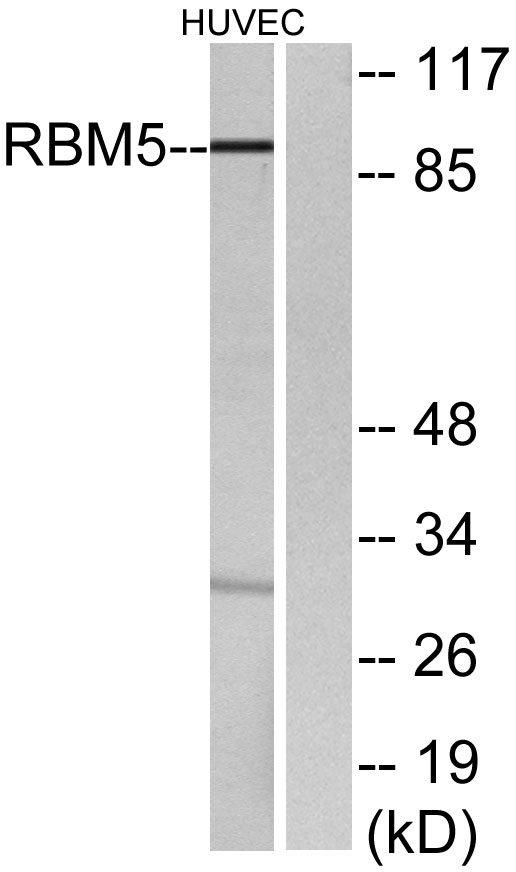LUCA15 Polyclonal Antibody
- Catalog No.:YT2604
- Applications:WB;IHC;IF;ELISA
- Reactivity:Human;Mouse
- Target:
- LUCA15
- Gene Name:
- RBM5
- Protein Name:
- RNA-binding protein 5
- Human Gene Id:
- 10181
- Human Swiss Prot No:
- P52756
- Mouse Gene Id:
- 83486
- Mouse Swiss Prot No:
- Q91YE7
- Immunogen:
- The antiserum was produced against synthesized peptide derived from human RBM5. AA range:226-275
- Specificity:
- LUCA15 Polyclonal Antibody detects endogenous levels of LUCA15 protein.
- Formulation:
- Liquid in PBS containing 50% glycerol, 0.5% BSA and 0.02% sodium azide.
- Source:
- Polyclonal, Rabbit,IgG
- Dilution:
- WB 1:500 - 1:2000. IHC 1:100 - 1:300. ELISA: 1:10000.. IF 1:50-200
- Purification:
- The antibody was affinity-purified from rabbit antiserum by affinity-chromatography using epitope-specific immunogen.
- Concentration:
- 1 mg/ml
- Storage Stability:
- -15°C to -25°C/1 year(Do not lower than -25°C)
- Other Name:
- RBM5;H37;LUCA15;RNA-binding protein 5;Protein G15;Putative tumor suppressor LUCA15;RNA-binding motif protein 5;Renal carcinoma antigen NY-REN-9
- Observed Band(KD):
- 92kD
- Background:
- This gene is a candidate tumor suppressor gene which encodes a nuclear RNA binding protein that is a component of the spliceosome A complex. The encoded protein plays a role in the induction of cell cycle arrest and apoptosis through pre-mRNA splicing of multiple target genes including the tumor suppressor protein p53. This gene is located within the tumor suppressor region 3p21.3, and may play a role in the inhibition of tumor transformation and progression of several malignancies including lung cancer. [provided by RefSeq, Oct 2011],
- Function:
- function:Component of the spliceosome A complex. Regulates alternative splicing of a number of mRNAs. May modulate splice site pairing after recruitment of the U1 and U2 snRNPs to the 5' and 3' splice sites of the intron. May both positively and negatively regulate aopotosis by regulating the alternative splicing of several genes involved in this process, including FAS and CASP2/caspase-2. In the case of FAS, promotes exclusion of exon 6 thereby producing a soluble form of FAS that inhibits apoptosis. In the case of CASP2/caspase-2, promotes exclusion of exon 9 thereby producing a catalytically active form of CASP2/Caspase-2 that induces apoptosis.,sequence caution:Wrong choice of CDS.,similarity:Belongs to the RBM5/RBM10 family.,similarity:Contains 1 C2H2-type zinc finger.,similarity:Contains 1 G-patch domain.,similarity:Contains 1 RanBP2-type zinc finger.,similarity:Contains 2 RRM (RNA
- Subcellular Location:
- Nucleus .
- Expression:
- Isoform 5 is widely expressed in normal tissues and is expressed at increased levels in T-leukemic cell lines.
- June 19-2018
- WESTERN IMMUNOBLOTTING PROTOCOL
- June 19-2018
- IMMUNOHISTOCHEMISTRY-PARAFFIN PROTOCOL
- June 19-2018
- IMMUNOFLUORESCENCE PROTOCOL
- September 08-2020
- FLOW-CYTOMEYRT-PROTOCOL
- May 20-2022
- Cell-Based ELISA│解您多样本WB检测之困扰
- July 13-2018
- CELL-BASED-ELISA-PROTOCOL-FOR-ACETYL-PROTEIN
- July 13-2018
- CELL-BASED-ELISA-PROTOCOL-FOR-PHOSPHO-PROTEIN
- July 13-2018
- Antibody-FAQs
- Products Images

- Western Blot analysis of various cells using LUCA15 Polyclonal Antibody cells nucleus extracted by Minute TM Cytoplasmic and Nuclear Fractionation kit (SC-003,Inventbiotech,MN,USA).

- Immunohistochemistry analysis of paraffin-embedded human brain tissue, using RBM5 Antibody. The picture on the right is blocked with the synthesized peptide.

- Western blot analysis of lysates from HUVEC cells, using RBM5 Antibody. The lane on the right is blocked with the synthesized peptide.



